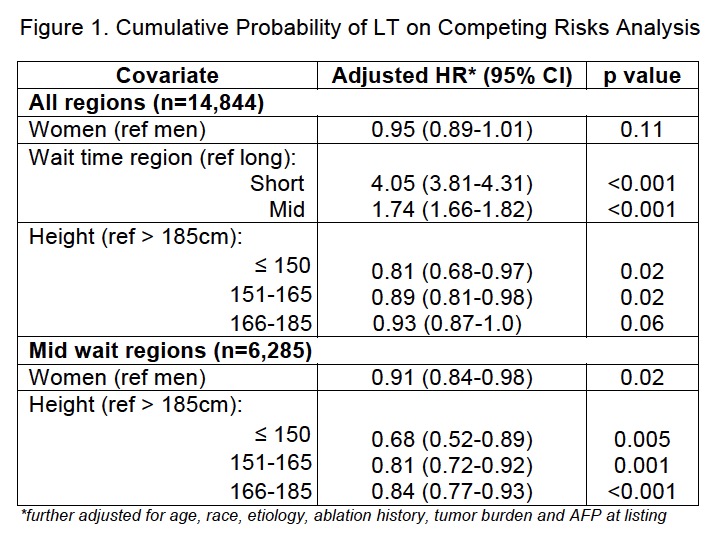In Mid Wait Regions Shorter Height and Female Sex Confer Lower Probability of Liver Transplant (LT) Among Patients with Hepatocellular Carcinoma (HCC).
UCSF, San Francisco
Meeting: 2017 American Transplant Congress
Abstract number: C185
Keywords: Allocation, Malignancy, Outcome, Split-liver transplantation
Session Information
Session Name: Poster Session C: Organ Allocation, Meld Score, Organ Utilization, and Transplant Outcomes
Session Type: Poster Session
Date: Monday, May 1, 2017
Session Time: 6:00pm-7:00pm
 Presentation Time: 6:00pm-7:00pm
Presentation Time: 6:00pm-7:00pm
Location: Hall D1
In the United States (U.S.) median MELD score at LT varies by region. Women without MELD exception have known longer wait times than men, which may relate to smaller stature. Whether probability of LT is lower in women with HCC exception, including across regions, is not known. Using the United Network for Organ Sharing database we conducted a retrospective study of adults listed with HCC T2 criteria between 2005-2015. Wait regions included short (SWR):3,10,11; mid (MWR):2,4,6,7,8; and long (LWR):1,5,9. Using competing risks (CR) analysis, we compared probability of LT by sex, while testing for interactions between sex, wait region and height. Of 14,844 LT listings for HCC, a higher proportion were in MWR (42%) than LWR (33%) or SWR (25%), with no regional differences by sex (p=0.35). The 3 year cumulative incidence of LT was lower in women than men (78% vs 80%, p<0.001), with greatest difference in MWR (77% vs 81%, p<0.001). In all regions women had longer wait times to LT (SWR 1.9 vs 1.5 (p=0.001); MWR 4.8 vs 4.1 (p<0.001); LWR 8.1 vs 7.5 months (p<0.04)). On adjusted analysis, shorter height and LWR had lower probability of LT, with trend toward lower probability in women (Figure 1). Significant interactions were identified between wait region, sex (p=0.006), and height (p<0.01), with women and shorter height (starting at 165cm, or 5'4”) having lower probability of LT in MWR. There was no significant difference by sex and height in SWR or LWR (p values >0.15). Split livers were twice as common in women than men across regions, with greatest use in men (2.3%) and women (4.7%) in LWTR. Conclusions: In MWR, shorter patients and women have lower probability of LT. This is not evident in SWR or LWR, perhaps due to low risk of dropout in SWR, and poor tumor biology leading to dropout in LWR, while those with favorable biology ultimately survive to LT regardless of sex and height. Recent changes to HCC policy will lengthen wait times across the U.S., therefore our findings may soon extend beyond MWR. Additional MELD exception for women and patients <5'4”, and greater split liver use may help to reduce sex and height-based disparities in organ access.
CITATION INFORMATION: Sarkar M, Kohi M, Dodge J, Roberts J, Mehta N. In Mid Wait Regions Shorter Height and Female Sex Confer Lower Probability of Liver Transplant (LT) Among Patients with Hepatocellular Carcinoma (HCC). Am J Transplant. 2017;17 (suppl 3).
To cite this abstract in AMA style:
Sarkar M, Kohi M, Dodge J, Roberts J, Mehta N. In Mid Wait Regions Shorter Height and Female Sex Confer Lower Probability of Liver Transplant (LT) Among Patients with Hepatocellular Carcinoma (HCC). [abstract]. Am J Transplant. 2017; 17 (suppl 3). https://atcmeetingabstracts.com/abstract/in-mid-wait-regions-shorter-height-and-female-sex-confer-lower-probability-of-liver-transplant-lt-among-patients-with-hepatocellular-carcinoma-hcc/. Accessed December 18, 2025.« Back to 2017 American Transplant Congress
